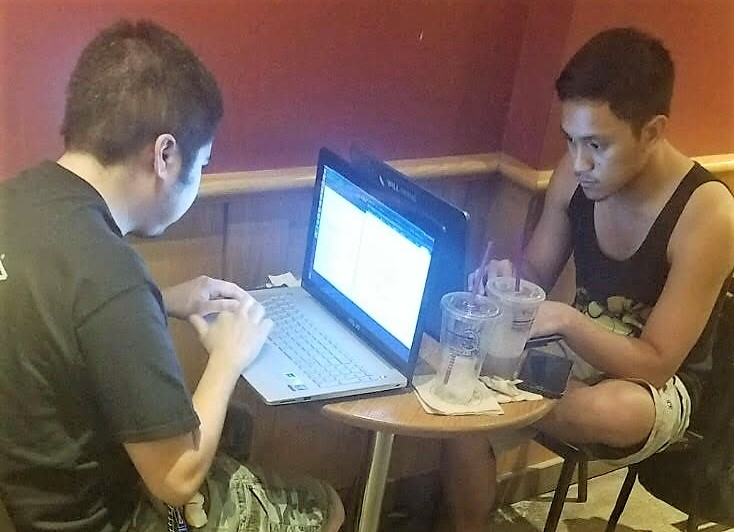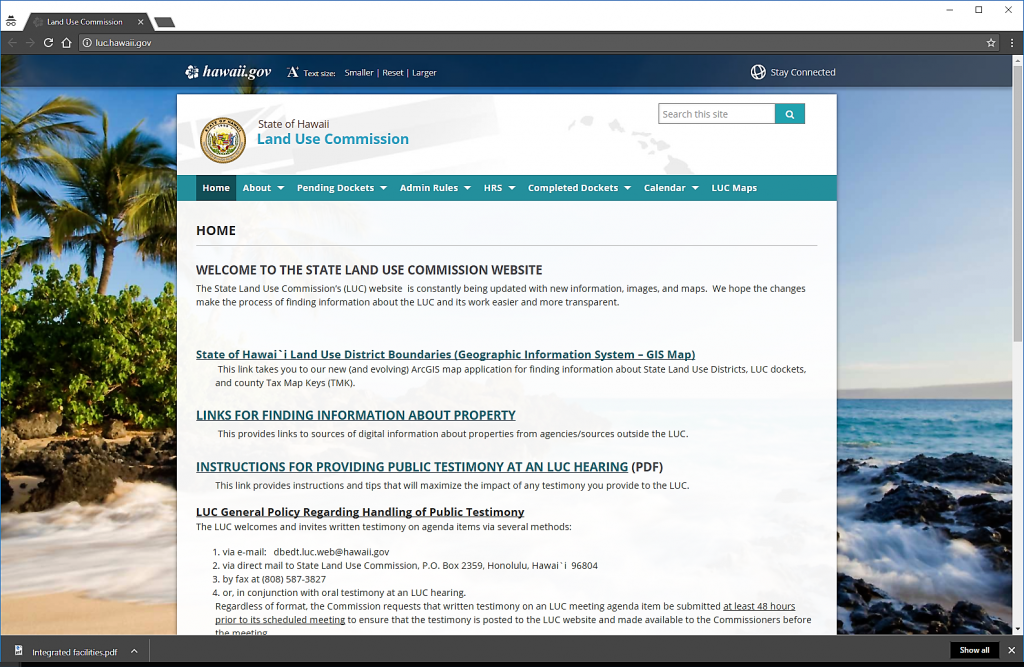
HATS team members Robert Kuakini (left) and Gabriel Farinas at work on a new website design
The state Land Use Commission has a prototype for an easier-to-use website, thanks to work by a team consisting of primarily UH West Oʻahu cybersecurity and computer networking students competing in the 2017 Hawaiʻi Annual Code Challenge.
The team from UH West Oʻahu overcame its lack of coding and other web design expertise to produce a model website for the state Land Use Commission (LUC), a body that helps in the classification of all land in Hawaiʻi into one of four land use classifications. The team did not win the competition, but walked away with valuable experience.
“The volunteers at the LUC were in need of a smoother and smarter application in processing, receiving, and sharing information to the public,” said Christine Joy Roica, team co-captain in an email. “Volunteers assist 20 to 30 people a day who have questions about processing their case, land use designation and property information, how to navigate the current LUC website, and more.”
At the start the West Oʻahu team, operating under the Hawaiʻi Advanced Technology Society (HATS) banner, determined the existing LUC site had a plethora of information, but that users still needed something easier to use in obtaining answers to questions about projects, land use designation, properties, testimonies and documents, according to Roica.

UHWO students worked on a design to improve the existing LUC website

UHWO students produced a design for a LUC website with the goal of making it easier to use
The team’s work resulted in a self-service, user-friendly website for receiving, sharing and processing information between the LUC and the public. A prototype was built that includes features for uploading dockets, Frequently Asked Questions, Search for pending and completed dockets, a contact us function, and other work.
“The website we created allows users to search for specific case documents and its status, and the website has a new frequently asked questions feature so users can find answers to their questions on their own,” Roica’s email said.
The Hawaiʻi Annual Code Challenge was sponsored by the Office of Enterprise Technology Services in partnership with the Hawaiʻi Technology Development Corp., Hawaiʻi Open Data, DevLeague, and multiple state departments and agencies. The competition is designed to engage the local technology community in modernizing state functions and services and to promote information technology workforce development.
Competition got underway on Aug. 26, with judging and presentations on Saturday, Sept. 23. Judges included Gov. David Ige; state Chief Technology Officer Todd Nacapuy; Bill & Melinda Gates Foundation Principal Technologist Miller Abel; and six others.
Robert Kuakini, a team member, said an LUC representative congratulated the team on translating the agency’s vision for the website into a tangible product and expressed an interest informally about adopting the work.
An LUC official said state Enterprise Technology Services is determining next steps for all entries, which are diverse and require review by a development team. A meeting with all Department Challenge Sponsors to share these next steps will be scheduled in the coming weeks.
The HATS team consisted of six current UH West Oʻahu students (Roica, Gabriel Farinas, Robert Kuakini, Catherine Sarte, Bryan Tanaka, and Taylor Kina); and two former UHWO students (Philippe Rigor and William Ng).
Five of the team members had served on teams that did well in National Cyber League competition – in 2017 a HATS team placed third nationally. Unfortunately the Hawaiʻi Annual Code Competition was not a cyber security challenge and the HATS team, while finding success with its client, did not place in the competition won by a team from the University of Hawaiʻi at Mānoa. Roica said HATS team members had little to average knowledge of coding.
But the group worked well as a team, meeting at Starbucks or Coffee Bean to discuss the project or collaborating online. Tasks were distributed based on each member’s interest and skill, Roica said. The team came out of the competition proud of building a website from scratch, the learning of new technology and producing something that’s less cluttered, operates more smoothly and is available 24-hours a day.
